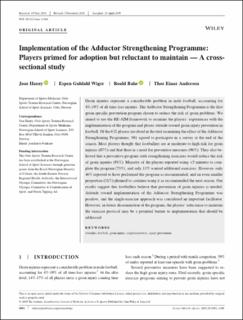| dc.contributor.author | Harøy, Joar | |
| dc.contributor.author | Wiger, Espen Guldahl | |
| dc.contributor.author | Bahr, Roald | |
| dc.contributor.author | Andersen, Thor Einar | |
| dc.date.accessioned | 2020-05-05T09:11:09Z | |
| dc.date.available | 2020-05-05T09:11:09Z | |
| dc.date.created | 2019-10-30T11:12:21Z | |
| dc.date.issued | 2019 | |
| dc.identifier.citation | Scandinavian Journal of Medicine & Science in Sports. 2019, 29(8), 1092-1100. | en_US |
| dc.identifier.issn | 0905-7188 | |
| dc.identifier.uri | https://hdl.handle.net/11250/2653299 | |
| dc.description | This is an open access article under the terms of the Creat ive Commo ns Attri bution License, which permits use, distribution and reproduction in any medium, provided the original work is properly cited. | en_US |
| dc.description.abstract | Groin injuries represent a considerable problem in male football, accounting for 4%‐19% of all time‐loss injuries. The Adductor Strengthening Programme is the first groin‐specific prevention program shown to reduce the risk of groin problems. We aimed to use the RE‐AIM framework to examine the players’ experiences with the implementation of the program and player attitude toward groin injury prevention in football. Of the 632 players involved in the trial examining the effect of the Adductor Strengthening Programme, 501 agreed to participate in a survey at the end of the season. Most players thought that footballers are at moderate to high risk for groin injuries (87%) and that there is a need for preventive measures (96%). They also believed that a preventive program with strengthening exercises would reduce the risk of groin injuries (91%). Majority of the players reported using <5 minutes to complete the program (73%), and only 11% wanted additional exercises. However, only 46% reported to have performed the program as recommended, and an even smaller proportion (31%) planned to continue using it as recommended the next season. Our results suggest that footballers believe that prevention of groin injuries is needed. Attitude toward implementation of the Adductor Strengthening Programme was positive, and the single‐exercise approach was considered an important facilitator. However, in future dissemination of the program, the players’ reluctance to maintain the exercise protocol may be a potential barrier to implementation that should be addressed. | en_US |
| dc.language.iso | eng | en_US |
| dc.subject | attitudes | en_US |
| dc.subject | football | en_US |
| dc.subject | groin injury | en_US |
| dc.subject | implementation | en_US |
| dc.subject | injury prevention | en_US |
| dc.title | Implementation of the Adductor Strengthening Programme: Players primed for adoption but reluctant to maintain? - A cross-sectional study | en_US |
| dc.type | Peer reviewed | en_US |
| dc.type | Journal article | en_US |
| dc.description.version | publishedVersion | en_US |
| dc.rights.holder | © 2019 The Authors. | en_US |
| dc.source.pagenumber | 1092-1100 | en_US |
| dc.source.volume | 29 | en_US |
| dc.source.journal | Scandinavian Journal of Medicine & Science in Sports | en_US |
| dc.source.issue | 8 | en_US |
| dc.identifier.doi | 10.1111/sms.13444 | |
| dc.identifier.cristin | 1742116 | |
| dc.description.localcode | Seksjon for idrettsmedisinske fag / Department of Sports Medicine | en_US |
| cristin.unitcode | 150,34,0,0 | |
| cristin.unitname | Seksjon for idrettsmedisinske fag | |
| cristin.ispublished | true | |
| cristin.fulltext | original | |
| cristin.qualitycode | 2 | |
